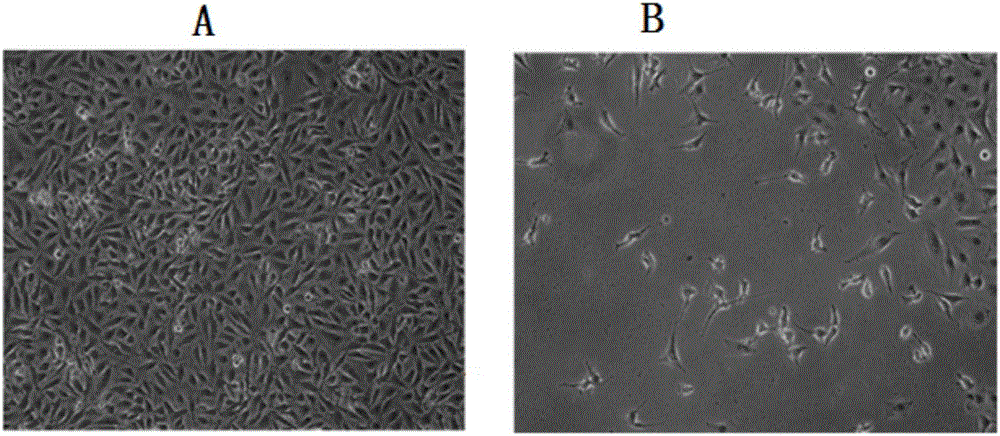Targeted superparamagnetic monodisperse nano-flower probe, preparation and application thereof
A nanoflower, monodisperse technology, applied in the field of nanoflower probes, can solve the problems of damage and side effects, and achieve the effect of accelerating the destruction of diseased cells, low cost, and excellent dispersion
- Summary
- Abstract
- Description
- Claims
- Application Information
AI Technical Summary
Problems solved by technology
Method used
Image
Examples
Embodiment 1
[0048] A method for preparing a targeted superparamagnetic monodisperse nanoflower probe, mainly comprising the following steps:
[0049] (1) Fe 3 o 4 Preparation of nanoflowers:
[0050] a. Add 2mmol of FeCl 3 ·6H 2 O is placed in the mixed solution of ethylene glycol and diethylene glycol with a volume ratio of 1:15, ultrasonically stirred for 5 minutes to stop the transparent viscous yellow solution;
[0051] b.N 2 Add 2g of polyvinylpyrrolidone (PVP) under protection, mechanically stir at a speed of 150rpm, and keep warm at 120°C for 0.5h to obtain a yellow-brown transparent solution;
[0052] c.N 2 Under protection, add 50mmol of NaAc, increase the mechanical stirring speed to 300rpm, stir for 30min, then transfer to a polytetrafluoro reactor, set the temperature to 180°C, and keep it warm for 10h to obtain the product;
[0053] d. Wash the product three times alternately with ultrapure water and absolute ethanol, and after magnetic separation and purification, dil...
Embodiment 2
[0077] (1) Fe 3 o 4 Preparation of nanoflowers:
[0078] a. Add 8mmol of FeCl 3 ·6H 2 O is placed in the mixed solution of ethylene glycol and diethylene glycol with a volume ratio of 3:17, and ultrasonically stirred for 8 minutes to stop the transparent viscous yellow solution;
[0079] b.N 2 Add 8 g of polyvinylpyrrolidone (PVP) under protection, mechanically stir at a speed of 200 rpm, and keep warm at 125° C. for 1 hour to obtain a yellow-brown transparent solution;
[0080] c.N 2 Under protection, add 70mmol of NaAc, increase the mechanical stirring speed to 400rpm, and after stirring for 40min, transfer it to a polytetrafluoro reactor, set the temperature to 210°C, and keep it warm for 15h to obtain the product;
[0081] d. Wash the product three times alternately with ultrapure water and absolute ethanol, and after magnetic separation and purification, dilute to 50 mL with ultrapure water to obtain a magnetic nanoparticle dispersion, which is set aside;
[0082] ...
Embodiment 3
[0100] (1) Fe 3 o 4 Preparation of nanoflowers:
[0101] a. 15mmol of FeCl 3 ·6H 2 O is placed in the mixed solution of ethylene glycol and diethylene glycol with a volume ratio of 5:15, and ultrasonically stirred for 8 minutes to stop the transparent viscous yellow solution;
[0102] b.N 2 Add 10g of polyvinylpyrrolidone (PVP) under protection, mechanically stir at a speed of 250rpm, and keep warm at 130°C for 1.5h to obtain a yellow-brown transparent solution;
[0103] c.N 2 Under protection, add 100mmol of NaAc, increase the mechanical stirring speed to 500rpm, stir for 50min, then transfer to a polytetrafluoro reactor, set the temperature to 250°C, and keep it warm for 20h to obtain the product;
[0104] d. Wash the product three times alternately with ultrapure water and absolute ethanol, and after magnetic separation and purification, dilute to 50 mL with ultrapure water to obtain a magnetic nanoparticle dispersion, which is set aside;
[0105] (2) Fe 3 o 4 Prep...
PUM
| Property | Measurement | Unit |
|---|---|---|
| particle diameter | aaaaa | aaaaa |
| particle diameter | aaaaa | aaaaa |
| size | aaaaa | aaaaa |
Abstract
Description
Claims
Application Information
 Login to View More
Login to View More - R&D
- Intellectual Property
- Life Sciences
- Materials
- Tech Scout
- Unparalleled Data Quality
- Higher Quality Content
- 60% Fewer Hallucinations
Browse by: Latest US Patents, China's latest patents, Technical Efficacy Thesaurus, Application Domain, Technology Topic, Popular Technical Reports.
© 2025 PatSnap. All rights reserved.Legal|Privacy policy|Modern Slavery Act Transparency Statement|Sitemap|About US| Contact US: help@patsnap.com



